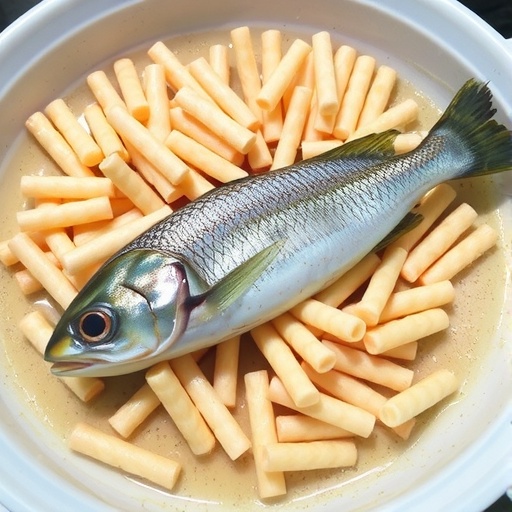In a groundbreaking study, researchers have delved into the prevalence of perfluorooctane sulfonate (PFOS) and perfluorooctanoic acid (PFOA) in seafood sourced from the coastal waters of Thailand. The investigation reveals alarming levels of these persistent organic pollutants, linking them to potential health risks for consumers. As global awareness of environmental contaminants intensifies, this study shines a critical light on the implications of consuming contaminated seafood and underscores the urgency for further regulatory scrutiny.
The study, spearheaded by Lertassavakorn, Pholphana, and Rangkadilok, employs advanced analytical techniques to measure PFOS and PFOA concentrations in various seafood samples. These compounds, known for their environmental persistence and bioaccumulative properties, have raised significant concerns within the scientific community. Their wide usage across industries has led to their ubiquitous presence in the environment, making them a focal point for research regarding human health risks associated with seafood consumption.
The researchers collected seafood samples from diverse geographic locations along the Thai coast, demonstrating a comprehensive approach to understanding the geographical distribution of PFOS and PFOA levels. This distribution is crucial as it may highlight specific areas where pollution is more pronounced, influencing future studies and regulatory efforts. By quantifying the concentration of these contaminants in seafood, the team aims to provide a clearer picture of the risks faced by local populations who heavily rely on seafood as a dietary staple.
One of the study’s pivotal findings reveals significantly elevated levels of PFOS and PFOA in certain seafood species compared to others. This variation is crucial for both consumers and policymakers, as it indicates which seafood options may pose higher risks. Additionally, understanding these variations can assist in guiding recommendations for seafood consumption among vulnerable populations, particularly children and pregnant women, who are more susceptible to harmful effects.
Quantifying dietary exposure is another significant aspect of this study. The researchers performed a risk assessment to estimate the potential health implications of consuming seafood contaminated with PFOS and PFOA. The results indicate that regular consumption of certain seafood varieties could lead to exposure levels above safe limits, underscoring the importance of public health initiatives aimed at educating consumers on safer seafood choices. This information is vital for consumers who might be unaware of the risks associated with certain seafood products.
The implications of PFOS and PFOA contamination extend beyond individual health; they also have significant environmental ramifications. These chemicals are known to accumulate in the food chain, posing risks not only to marine life but also to the ecosystems that sustain them. The presence of such persistent chemicals in seafood, a crucial part of both cultural and economic life in Thailand, raises questions about environmental policies and their effectiveness in mitigating pollution.
Additionally, the study brings attention to the broader issue of chemical pollution in the marine environment. With increasing industrial activity and urbanization along coastlines, the potential for further contamination incidents rises. This research serves as a clarion call for further investigation into other potential pollutants that might be affecting seafood quality and safety. Without robust environmental regulations and monitoring, the long-term sustainability of seafood as a food resource may be jeopardized.
Furthermore, the findings of this study contribute to the global discourse on chemical safety and pollution management. As nations strive to meet clean water and food safety standards, the lessons learned from this research could inform strategies not only in Thailand but also in other regions grappling with similar contamination issues. Policymakers are urged to consider implementing stricter regulations regarding the discharge of perfluoroalkyl substances into waterways and monitoring seafood products for safety.
For consumers, this study highlights the necessity of being informed about the origins of their seafood. Understanding which species are less likely to harbor harmful levels of PFOS and PFOA empowers individuals to make safer dietary choices. Seafood lovers and those relying on seafood as a primary protein source are encouraged to stay informed about the latest research findings and recommendations regarding food safety.
As the scientific community continues to explore the ramifications of PFOS and PFOA, collaboration between researchers, policymakers, and the public is more important than ever. Collective efforts can lead to enhanced regulations that protect not only consumer health but also the integrity of the marine environment. Highlighting the intertwined nature of human health and environmental health, this research underscores the need for an interdisciplinary approach to tackle pollution and its effects comprehensively.
In response to this research, stakeholders in the seafood industry, including fishermen, suppliers, and retailers, are called to action. Improved practices for seafood sourcing and handling, as well as transparent communication with consumers, are crucial steps toward regaining public trust and ensuring food safety. The industry must proactively address contamination concerns and contribute to wider efforts aimed at environmental conservation.
In conclusion, this significant study sheds light on the troubling presence of PFOS and PFOA in seafood from Thailand, emphasizing the urgent need for enhanced monitoring and communication regarding marine contaminants. As the repercussions of this research resonate across the scientific and public realms, it serves as a powerful reminder of the complexities surrounding environmental health and consumer safety. The call for action extends not just within Thailand but across the globe, urging collective responsibility in combating marine pollution and ensuring a safer dietary future.
Subject of Research: The prevalence of perfluorooctane sulfonate (PFOS) and perfluorooctanoic acid (PFOA) in seafood from Thailand.
Article Title: Perfluorooctane sulfonate (PFOS) and perfluorooctanoic acid (PFOA) in seafood from Thailand: Levels, geographic distribution, and risk from dietary exposure.
Article References:
Lertassavakorn, T., Pholphana, N., Rangkadilok, N. et al. Perfluorooctane sulfonate (PFOS) and perfluorooctanoic acid (PFOA) in seafood from Thailand: Levels, geographic distribution, and risk from dietary exposure.
Environ Monit Assess 197, 1258 (2025). https://doi.org/10.1007/s10661-025-14715-x
Image Credits: AI Generated
DOI:
Keywords: PFOS, PFOA, seafood contamination, dietary exposure, environmental pollution, Thailand, food safety, public health.




